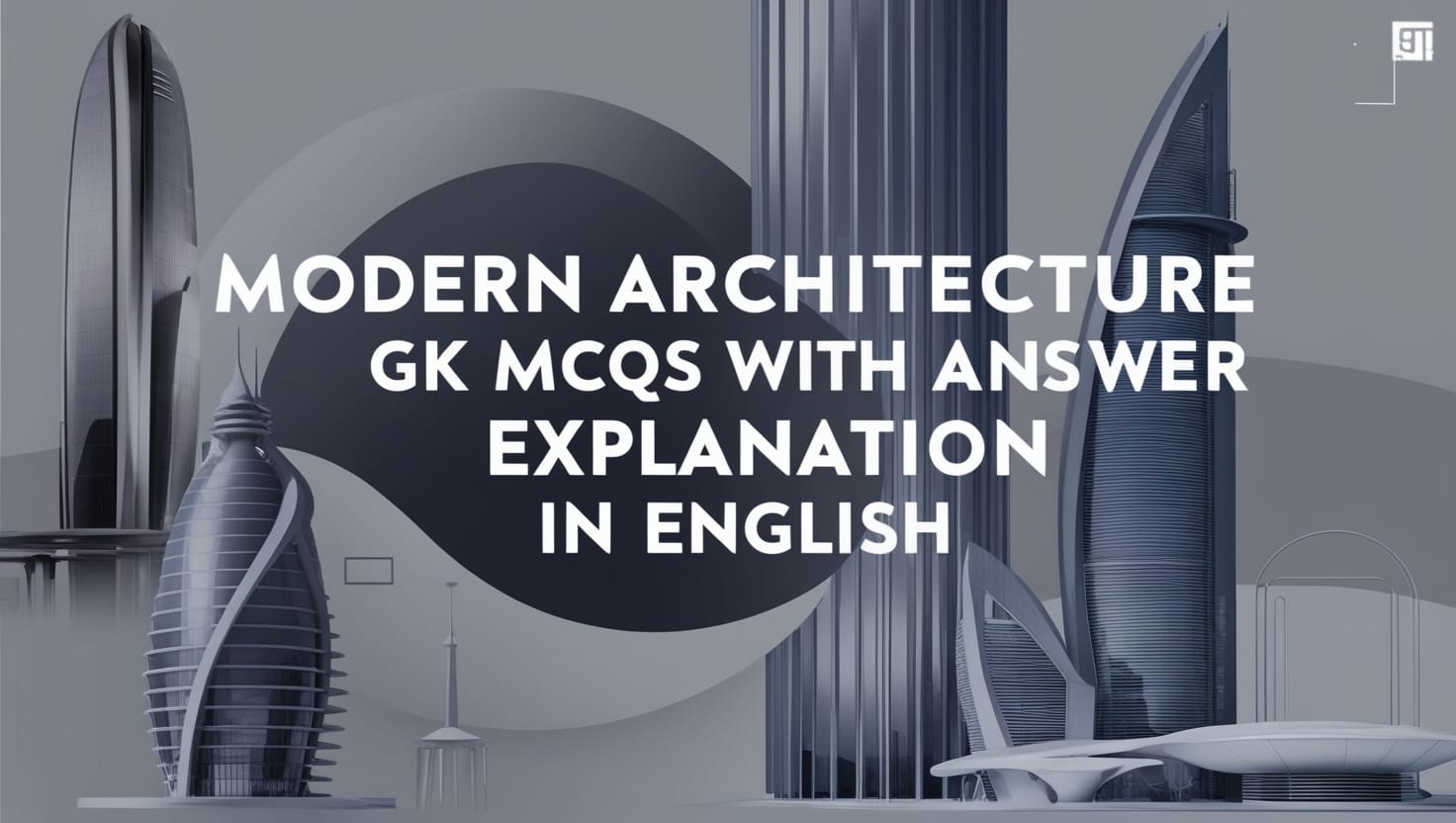
Modern architecture represents a revolutionary shift in design, emphasizing functionality, innovation, and simplicity over ornate traditions. In this article, titled Modern Architecture GK MCQs With Answer & Explanation in English, we delve into essential concepts, historical milestones, and influential architects that shaped this transformative era.
Designed to enhance your general knowledge, the MCQs provide accurate answers and in-depth explanations, making it an ideal resource for competitive exams and architectural enthusiasts alike. Let’s explore the fascinating world of modern architecture!
1. Nipponzon Myohoji Buddhist temple or commonly called Peace Pagoda or Shanti Stupa was established by who among the following?
- Fuji Guru
- Ashoka
- King Devanampiyatissa
- Mahatma Gandhi
Show Answer
Answer: Fuji Guru
The Nipponzan Myohoji Buddhist temple, commonly known as the Peace Pagoda or Shanti Stupa, was established by Nichidatsu Fujii, a Japanese Buddhist monk and founder of the Nipponzan-Myohoji order. Inspired by Mahatma Gandhi after their meeting in 1931, Fujii dedicated his life to promoting non-violence and peace. The Peace Pagoda is a symbol of his commitment and stands as a monument to world peace. There are several Peace Pagodas around the world, including in India, built with the goal of spreading the message of non-violence and harmony.
2. Who among the following was instrumental in designing New Delhi in collaboration with Edwin Lutyens?
- John Abel
- Thomas Warr Attwood
- Simon Basil
- Herbert Baker
Show Answer
Answer: Herbert Baker
Herbert Baker played a significant role in designing New Delhi, working in collaboration with British architect Edwin Lutyens. Lutyens is best known for designing New Delhi’s iconic structures, including the Viceroy’s House, which is now the Rashtrapati Bhavan, the official residence of the President of India. The combined effort of Baker and Lutyens resulted in the planning and construction of New Delhi as India’s new capital city during British colonial rule.
3. Which European company brought the Iberian style of architecture to India?
- Dutch
- French
- Portuguese
- British
Show Answer
Answer: Portuguese
The Iberian style of architecture was brought to India by the Portuguese during their colonial period. Also known as Isabelline Gothic or Castilian Late Gothic, it was the dominant architectural style in the Crown of Castile during the late 15th and early 16th centuries. Portuguese influence can be seen in several structures in India, particularly churches in regions like Goa and West Bengal, reflecting this Iberian architectural style.
4. Which are the Portuguese monuments in India?
- Bandel Church in West Bengal
- Joan of Arc at Dumas street
- Moor Market in Chennai
- Gateway of India in Mumbai
Show Answer
Answer: Bandel Church in West Bengal
Bandel Church in West Bengal on the banks of the Hooghly River is one of the Portuguese monuments in India. In Mumbai, structures like the Madh Fort, Castella de Aguada, and St. John’s Baptist Church have survived from the Portuguese colonial rule.
5. Which modern architecture is seen in Puducherry, Bengal, Karaikal, Mahe, etc.?
- Portuguese architecture
- French architecture
- British architecture
- Dutch architecture
Show Answer
Answer: French architecture
French architecture is visible in regions like Puducherry, Bengal, Karaikal, Mahe, and other former French colonial territories in India. French architects adapted their designs to use local materials and consider climatic conditions, resulting in a unique blend of French and Indian architectural elements.
6. In which architecture did the Portuguese establish impressive churches in Goa?
- Iberian Architecture
- Palladian Architecture
- Indo-Saracenic Architecture
- None of these
Show Answer
Answer: Iberian Architecture
The Portuguese established impressive churches in Goa in the style of Iberian architecture. These churches reflect the architectural influence of the Iberian Peninsula.
7. Which European company introduced the Palladian style?
- British
- Portuguese
- French
- Dutch
Show Answer
Answer: British
The Palladian style was introduced by a British officer in the 18th century. An example of this style is the Constantia, built by General Martin in Lucknow. The Palladian style, characterized by classical elements, was adapted in India during the British colonial period, and it influenced certain architectural designs.
8. Who designed the Gateway of India in Mumbai?
- General Martin
- FW Stevens
- FS Growse
- G Wittet
Show Answer
Answer: G Wittet
George Wittet designed the Gateway of India in Mumbai. This prominent monument was constructed in the Indo-Saracenic style to commemorate the visit of King-Emperor George V in 1911. The Indo-Saracenic architectural style combines Indian, Islamic, and European elements, and it is exemplified by structures like the Gateway of India.
9. What is the Indo-Saracenic architecture also known as?
- Indo-Gothic
- Mughal-Gothic
- Neo-Mughal
- All of the above
Show Answer
Answer: All of the above
Indo-Saracenic architecture, also known as Indo-Gothic, Mughal-Gothic, or Neo-Mughal, was a revivalist architectural style adopted by British architects in India during the later 19th century. This style combines various influences, including Indian, Islamic, and European elements, to create a unique architectural fusion. Notable examples include the Victoria Terminus station in Mumbai.
10. Victoria Terminus station in Mumbai was designed by?
- G Wittet
- FW Stevens
- FS Growse
- None of these
Show Answer
Answer: FW Stevens
Victoria Terminus station in Mumbai was designed by FW Stevens. It is an example of Victorian Gothic revival architecture in India and incorporates themes from Indian traditional architecture.







